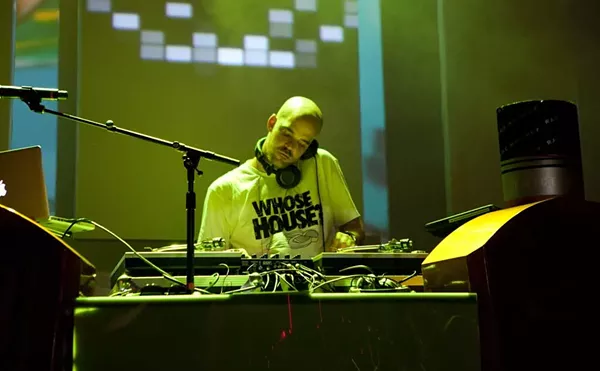As you've probably heard by now, last month ago Ryan Adams released his highly anticipated cover album of Taylor Swift's 1989 on his Pax-Am label. Twitter and I got busy listening, parsing what significance might be gleaned from these stripped-down, guitar-based, Smiths-style takes on the pop songs that have lorded over our cultural souls this year.
Other than the oddity of one popular artist releasing covers of already-ubiquitous songs, the project is unsurprising. Adams' 2014 self-titled release achieved critical and commercial success, and Ryan Adams demonstrated a return to the '80s-influenced electric pop-rock of 2004's Love Is Hell. That album itself was a departure from the alt-country and acoustic rock that introduced him to critics and die-hard fans. He and Swift drew from adjacent wells of big choruses on their latest releases, and can relate on the crossover experience (fraught for Adams, triumphant for Swift).
Grantland's Steven Hyden articulated the love-fest between Adams the "cult hero" and the "epitome of mainstream pop," while Swift herself credits him as a songwriting influence: "In this scenario, artists aren't mere pawns in a tired ideological battle — they meet each other in the middle in order to exchange ideas and harmonize."
Despite my long-standing, overwhelming, kiss-them-in-the-pouring-rain love for both artists, I still had a few reservations:
1. For a supposedly spontaneous project put out by Adams on his own label, the hype surrounding its creation and release had the air of a next-level social-media Swiftian mechanization. Any post wherein Tay fangirls out is an undeniable bump, but perhaps I underestimate Adams' own Insta-savvy, considering his 60,000 IG followers and 712,000 Twitter followers.
2. Some may insist that Ryan Adams — poster boy for the prolific, smart, occasionally obscure, guitar-guy, American indie artist — paying homage to a seemingly homogenous mega-star supports the Washington Post's Chris Richards' argument that poptimism leads to a degradation of dissent. Will complex critical conversation weaken when even our prickliest pop saviors crawl inside a cozy consensus?
3. If even a portion of Taylor's artistic and critical success is due to these mainstream poptimist times — when the pervasive perspective of pop music is focused on the feminine experience and is even a bit more pluralist than previous eras — then what do we lose or gain by doling out attention to a white, straight, middle-aged guitar dude appropriating the material?
Only one way to find out: Let's listen to the record.
The first impression of Adams' 1989 is that this is no piss-take. Adams treats the material with reverence, lending the songs full-bodied, thoughtful arrangements and singing his heart out. Much of the album recalls the atmosphere of Ryan Adams, a mix of mid-century influences that are now his sweet spot. This includes the beefed-up surge of "Style" with lyrics updated to include a Sonic Youth reference: "You've got that Daydream Nation look in your eye." On "Wildest Dreams," Adams trades in the original's Lana Del Rey languor for mid-tempo Tom Petty chiming country.
Two songs that stand out as new (new, not necessarily better) takes are "Shake It Off," which Adams distills to a lonely echo that invokes Springsteen calling to himself in the dark of "Atlantic City." (No god-awful rap interlude, praise be!) Where Swift's "Out of the Woods" is a thundering wonder of layered vocals, Adams unravels the song into a six-minute, finger-picked odyssey that's as excruciating as it is delicate.
What these versions do (even including "Bad Blood," which equates to Adams' second-best cover, "Wonderwall") is further reveal the gleaming bones of these already-formidable pop songs.
To be clear: Swift and 1989 did not need the Adams treatment, and did not benefit from any sort of authenticity "validation." Neither the concept nor the result is radical. It's mutually beneficial to the artists involved, not to mention listeners who get two stellar versions of a pop album that already feels timeless. Rather than Adams co-opting femme-made, femme-centric art, the album feels like a celebration that points to the sheer, simple majesty of her (co-)songwriting. Like all pop stars (including Adams), Swift's success partially depends on her personality and branding genius, but her material has always been tops. Isn't that how it should be?
What's most exciting is how Adams' re-creations might influence Swift's further artistic development (and complete conquest of my soul). An early narrative about Swift was that she wrote break-up songs, notorious for allusions to high-profile boys who dissed her. However, those Taylor Swift songs are not about real heartbreak; they describe the fantasy of the crush, of early-aborted infatuation — hence the oft-repeated imagery of red lips, sunsets, nice dresses, passenger seats, kissing in the pouring rain, the girl running out crying with the object of desire following close behind. The relationships never last long enough to morph from romance into love.
Adams, on the other hand, is our greatest auteur of love's suffering, ending, and aftermath. Even when he's having a blast (which he clearly is on 1989), he can't help but infuse the songs with his sad-bastard sensibility. Or perhaps he draws out the ache that's already lurking below the shine. Swift is growing ever more worldly and wise, even as she directs us to lean on our friends and celebrate our power.
I often wonder what Swift will do next, how she will demonstrate continued growth and depth. I would suggest she get heartbroken for real, get a bad review, go to war with her label, make her own "Come Pick Me Up" and Love Is Hell. For Swift's next evolution, she's got to know: Love isn't a nice dress. Love is hell. Love is what levels you. Love is the gravel that falls from your knees when you finally rise. If there's anyone today who can pick herself up for the good of pop music, it's Taylor Swift.
This piece originally ran on the website of our sister paper, the St Louis Riverfront Times.






